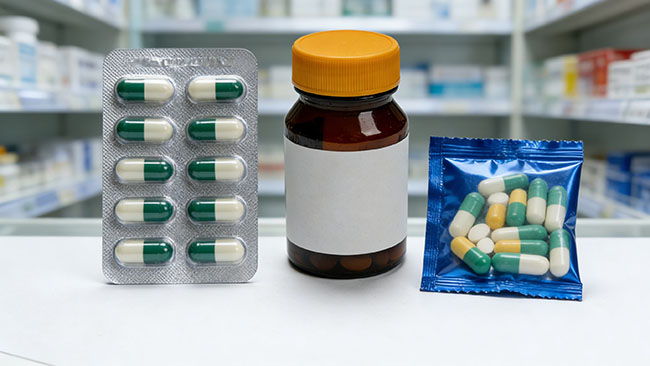Εισαγωγή στη συσκευασία κυψέλης
Κατανόηση συσκευασία blister είναι απαραίτητο για τους κατασκευαστές φαρμακευτικών προϊόντων, τους μηχανικούς συσκευασίας, τους παρόχους υγειονομικής περίθαλψης και τους ασθενείς. Αυτός ο ολοκληρωμένος οδηγός εξερευνά τι είναι οι συσκευασίες κυψέλης, πώς κατασκευάζονται, τα οφέλη και τους περιορισμούς τους, καθώς και τη σχέση τους με τον εξοπλισμό παραγωγής ανάντη, όπως περιστροφικές μηχανές πρέσας δισκίωνΕίτε ασχολείστε με την παραγωγή φαρμακευτικών προϊόντων είτε απλώς ενδιαφέρεστε για τη συσκευασία που προστατεύει τα φάρμακά σας, αυτός ο οδηγός παρέχει πολύτιμες πληροφορίες σχετικά με αυτήν την πανταχού παρούσα τεχνολογία συσκευασίας.
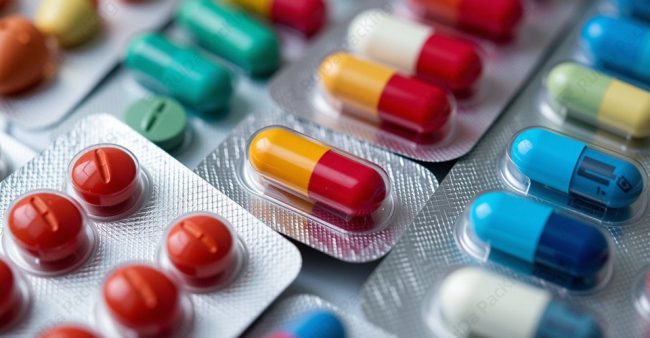
Βασικές αρχές των συσκευασιών κυψέλης
Τι ακριβώς είναι μια συσκευασία κυψέλης;
Οι συσκευασίες κυψέλης είναι μια μορφή συσκευασίας μοναδιαίας δόσης που χαρακτηρίζεται από:
Μεμονωμένες κοιλότητεςΘύλακες από πλαστικό ή αλουμίνιο, καθεμία από τις οποίες περιέχει μία μόνο δοσολογική μονάδα
Θερμικά σφραγισμένο υπόστρωμαΈνα υλικό επικάλυψης (συνήθως αλουμινόχαρτο ή χαρτί) σφραγισμένο στο διαμορφωμένο φύλλο
Σχεδιασμός με δυνατότητα ώθησηςΕπιτρέψτε την πρόσβαση στο φάρμακο πιέζοντας μέσα από το υλικό υποστήριξης
ΟρατότηταΣυνήθως διαφανές τουλάχιστον στη μία πλευρά για την αναγνώριση του προϊόντος
Διαδικασία Φόρμας-Γεμίσματος-ΣφραγίσματοςΔημιουργήθηκε μέσω αυτοματοποιημένων διαδικασιών διαμόρφωσης, πλήρωσης και σφράγισης
Παρουσίαση Μοναδιαίας ΔόσηςΚάθε μονάδα φαρμάκου παραμένει σφραγισμένη μέχρι να χρειαστεί
Αυτός ο σχεδιασμός δημιουργεί ένα προστατευτικό μικροπεριβάλλον για κάθε φαρμακευτικό προϊόν, διατηρώντας την ακεραιότητά του από την παραγωγή σε μηχανές πρέσας δισκίων έως τη διανομή και τη χρήση.
Η Ανατομία της Σύγχρονης Συσκευασίας Μπλίστερ
Μια τυπική συσκευασία κυψέλης αποτελείται από πολλά εξαρτήματα:
Σχηματίζοντας μεμβράνη: Το πλαστικό ή το αλουμινένιο υλικό που σχηματίζει κοιλότητες (φουσκάλες)
Υλικό καλύμματος: Το φύλλο υποστήριξης σφραγισμένο στη διαμορφωμένη μεμβράνη
Επιμελητήριο Προϊόντων: Ο χώρος που περιέχει το φάρμακο
Περιοχή σφράγισης: Η περίμετρος γύρω από κάθε κοιλότητα όπου συνδέονται τα υλικά
Γραμμές διάτρησηςΕπιτρέπει τον διαχωρισμό των μεμονωμένων δόσεων (σε ορισμένα σχέδια)
ΕκτύπωσηΠληροφορίες προϊόντος, αριθμοί παρτίδας, ημερομηνίες λήξης
Χαρακτηριστικά ασφαλείας για παιδιάΠρόσθετοι μηχανισμοί για την αποτροπή μη εξουσιοδοτημένης πρόσβασης
Η κατανόηση αυτών των στοιχείων σας βοηθά να εκτιμήσετε την μηχανική πολυπλοκότητα πίσω από αυτά τα φαινομενικά απλά πακέτα.
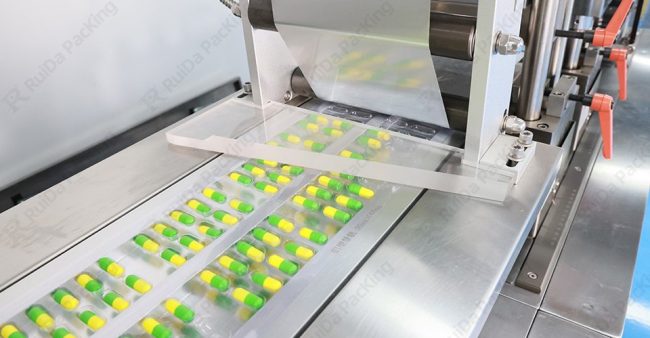
Τύποι συσκευασιών κυψέλης σε φαρμακευτικές συσκευασίες
Θερμοδιαμορφωμένες πλαστικές συσκευασίες κυψέλης
Ο πιο συνηθισμένος τύπος συσκευασίας σε μπλίστερ χρησιμοποιεί πλαστικά που μπορούν να διαμορφωθούν με θερμότητα:
PVC (Πολυβινυλοχλωρίδιο)Βασική, οικονομική επιλογή με μέτριες ιδιότητες φραγμού
PVC/PVDC (PVC με χλωριούχο πολυβινυλιδένιο)Ενισχυμένο φράγμα υγρασίας
PVC/PE/PVDC (Πολυστρωματικό)Περαιτέρω βελτιωμένη προστασία από την υγρασία
PVC/Aclar: Υψηλής ποιότητας φράγμα υγρασίας με χρήση πλαστικοποίησης φθοροπολυμερούς
PETG (Πολυαιθυλενοτερεφθαλική γλυκόλη): Διαυγής, ανακυκλώσιμη εναλλακτική λύση
PP (Πολυπροπυλένιο)Καλή χημική αντοχή και ανακυκλωσιμότητα
Οι θερμοδιαμορφωμένες κυψέλες προσφέρουν ορατότητα προϊόντος και οικονομικό κόστος παραγωγής, παρέχοντας παράλληλα επαρκή προστασία για πολλά φάρμακα.
Συσκευασίες κυψέλης αλουμινίου ψυχρής μορφοποίησης
Για προϊόντα που απαιτούν μέγιστη προστασία:
Αλουμίνιο/Αλουμίνιο: Φράγμα υψηλής ποιότητας με χρήση αλουμινίου τόσο για διαμόρφωση όσο και για επικάλυψη
OPA/Al/PVC (Προσανατολισμένο Πολυαμίδιο/Αλουμίνιο/PVC): Επιλογή πολλαπλών στρώσεων ψυχρής μορφοποίησης
PVC/PE/PVDC/AlΣύνθετες ελασματοποιήσεις για εξειδικευμένες εφαρμογές
Οι κυψέλες ψυχρής μορφοποίησης παρέχουν ανώτερη προστασία από την υγρασία, το οξυγόνο και το φως, καθιστώντας τες ιδανικές για ευαίσθητα φάρμακα που παράγονται σε μηχανές πρέσας δισκίων υψηλής ακρίβειας.
Εξειδικευμένα σχέδια για φουσκάλες
Η καινοτομία έχει οδηγήσει σε αρκετές εξειδικευμένες παραλλαγές:
Τροπικές φουσκάλεςΒελτιωμένες ιδιότητες φραγμού για περιβάλλοντα υψηλής υγρασίας
Φουσκάλες ελεγχόμενης θερμοκρασίαςΓια προϊόντα ψυχρής αλυσίδας ή προϊόντα ευαίσθητα στη θερμότητα
Φουσκάλες ανθεκτικές στα παιδιάΜε πρόσθετους μηχανισμούς ανοίγματος για ασφάλεια
Σχέδια φιλικά προς τους ηλικιωμένουςΙσορροπία προστασίας με προσβασιμότητα για ηλικιωμένους χρήστες
Πακέτα ΗμερολογίουΣυμπεριλάβετε σημάνσεις ημέρας/ημερομηνίας για την παρακολούθηση της συμμόρφωσης με τη φαρμακευτική αγωγή
Φουσκάλες πολλαπλών προϊόντων: Περιέχει διαφορετικά φάρμακα σε ένα συνταγογραφούμενο σχήμα
Αυτές οι εξειδικευμένες μορφές αντιμετωπίζουν συγκεκριμένες προκλήσεις στη διανομή και τη χρήση φαρμακευτικών προϊόντων, διατηρώντας παράλληλα τα βασικά οφέλη της συσκευασίας blister.
Η διαδικασία κατασκευής συσκευασίας κυψέλης
Από την πρέσα tablet στη γραμμή συσκευασίας
Η διαδικασία από τις πρώτες ύλες έως τις τελικές συσκευασίες blister ακολουθεί τα εξής στάδια:
Ανάπτυξη ΣυνταγώνΔημιουργία σύνθεσης δισκίου ή κάψουλας
Λειτουργία Πιεστηρίου TabletΣυμπίεση σκόνης σε δισκία χρησιμοποιώντας μηχανές πρέσας δισκίων
Έλεγχος ποιότητας μετά τη συμπίεσηΔιασφάλιση ότι το tablet πληροί τις προδιαγραφές
Μεταφορά στην περιοχή συσκευασίαςΕλεγχόμενη κίνηση των δισκίων στη γραμμή της κυψέλης
Σχηματισμός κυψελώνΔημιουργία κοιλοτήτων κατά τη διαμόρφωση του υλικού
Γέμισμα προϊόντοςΤοποθέτηση δισκίων από την πρέσα δισκίων σε σχηματισμένες κοιλότητες
Εφαρμογή σφράγισηςΕφαρμογή και θερμική σφράγιση του υλικού επικάλυψης
Τελικές Λειτουργίες ΣυσκευασίαςΚοπή, διάτρηση και δευτερογενής συσκευασία
Αυτή η ολοκληρωμένη διαδικασία συνδέει τη λειτουργία της μηχανής πρέσας δισκίων απευθείας με τη συσκευασία σε κυψέλες, με ποιοτικό έλεγχο σε κάθε σημείο μετάβασης.
Διαδικασία θερμοδιαμόρφωσης
Για πλαστικά υλικά κυψέλης:
Τροφοδοσία υλικού: Πλαστικό ρολό εισέρχεται στη μηχανή blister
Σταθμός θέρμανσηςΤο υλικό φτάνει σε θερμοκρασία διαμόρφωσης (συνήθως 120-180°C)
Σταθμός σχηματισμούΘερμαινόμενο πλαστικό που εισάγεται σε καλούπια με κοιλότητα χρησιμοποιώντας κενό ή πίεση
Φάση ψύξηςΟι σχηματισμένες κοιλότητες στερεοποιούνται για να διατηρήσουν το σχήμα τους
ΠλήρωσηΠροϊόντα από μηχανή πρέσας δισκίων τοποθετημένα σε διαμορφωμένες κοιλότητες
ΣφράγισηΥλικό επικάλυψης θερμικά σφραγισμένο σε διαμορφωμένο φύλλο
Φινίρισμα: Εργασίες κοπής, διάτρησης και δευτερογενούς συσκευασίας
Η διαδικασία θερμοδιαμόρφωσης πρέπει να ευθυγραμμίζεται με τους ρυθμούς εξόδου της πρέσας δισκίων για να διατηρείται η αποτελεσματική ροή παραγωγής.
Διαδικασία ψυχρής διαμόρφωσης
Για υλικά κυψέλης αλουμινίου:
Τροφοδοσία υλικού: Το φύλλο αλουμινίου εισέρχεται στη μηχανή φουσκαλών
Προετοιμασία πριν από τη διαμόρφωση: Υλικό τοποθετημένο για διαμόρφωση
Κρύα διαμόρφωσηΥλικό τεντωμένο σε σχήμα κοιλότητας χρησιμοποιώντας μηχανική πίεση
ΠλήρωσηΠροϊόντα από περιστροφική πρέσα δισκίων τοποθετημένα σε διαμορφωμένες κοιλότητες
ΣφράγισηΥλικό επικάλυψης θερμικά σφραγισμένο σε διαμορφωμένο φύλλο
Φινίρισμα: Εργασίες κοπής και δευτερογενούς συσκευασίας
Η ψυχρή διαμόρφωση διατηρεί τις μέγιστες ιδιότητες φραγμού για εξαιρετικά ευαίσθητα προϊόντα που απαιτούν απόλυτη προστασία.
Υλικά για φουσκάλες και οι ιδιότητές τους
Σχηματισμός φιλμ και τα χαρακτηριστικά τους
| Υλικό | Φράγμα υγρασίας | Φράγμα οξυγόνου | Προστασία από το φως | Κόστος | Ανακυκλωσιμότητα |
|---|---|---|---|---|---|
| PVC | Χαμηλός | Χαμηλός | Χαμηλός | Χαμηλός | Περιωρισμένος |
| PVC/PVDC | Μέτρια-Υψηλή | Μέσον | Χαμηλός | Μέσον | Περιωρισμένος |
| PVC/Aclar | Πολύ Υψηλό | Μέσον | Χαμηλός | Ψηλά | Περιωρισμένος |
| PETG | Μέσον | Μέσον | Χαμηλός | Μέσον | Καλός |
| ΡΡ | Μέσον | Χαμηλός | Χαμηλός | Μέσον | Καλός |
| Αλουμίνιο | Πολύ Υψηλό | Πολύ Υψηλό | Πλήρης | Ψηλά | Καλός |
Η επιλογή υλικού επηρεάζει άμεσα τη διάρκεια ζωής του προϊόντος, το επίπεδο προστασίας και το περιβαλλοντικό αποτύπωμα.
Υλικά επικάλυψης
Οι επιλογές υλικού υποστήριξης περιλαμβάνουν:
Φύλλο αλουμινίου: Στάνταρ επιλογή με εξαιρετικές ιδιότητες φραγμού
Φύλλο με χαρτόκουτοΕυκολότερο σκίσιμο για βελτιωμένη πρόσβαση
Αποφλοιώσιμο ΚάλυμμαΕπιτρέπει το άνοιγμα χωρίς να χρειάζεται να σπρώξετε
Ασφαλή για παιδιά ελασματοποιημένα φύλλαΠολλαπλά επίπεδα που απαιτούν συντονισμένες δράσεις
Εκτυπώσιμα φύλλα αλουμινίουΕπιτρέπεται η προβολή επωνυμίας και πληροφοριών απευθείας στο φόντο
Σχέδια που δεν παραβιάζονται: Εμφάνιση ορατών ενδείξεων ανοίγματος της συσκευασίας
Η επιλογή καλύμματος εξισορροπεί την προστασία, την πρόσβαση των χρηστών και τις απαιτήσεις επικοινωνίας.
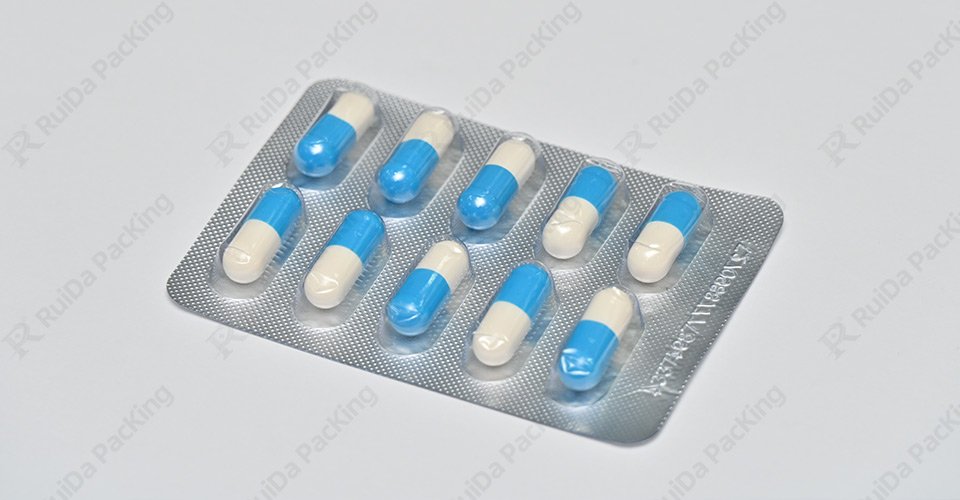
Οφέλη από τη συσκευασία κυψελών στα φαρμακευτικά προϊόντα
Πλεονεκτήματα προστασίας προϊόντων
Οι συσκευασίες κυψέλης παρέχουν σημαντική προστασία για προϊόντα που κατασκευάζονται σε μηχανές πρέσας δισκίων:
Φράγμα υγρασίαςΑποτρέπει τη ζημιά από την υγρασία σε προϊόντα ευαίσθητα στην υγρασία
Προστασία οξυγόνουΜειώνει την οξείδωση ευάλωτων ενώσεων
Φωτεινή θωράκισηΕλαχιστοποιεί τη φωτοαποικοδόμηση με αδιαφανή υλικά
Πρόληψη ΜόλυνσηςΔιατηρεί την στειρότητα μέχρι τη χρήση
Φυσική ΠροστασίαΑποτρέπει τη σύνθλιψη ή τη ζημιά κατά τη διανομή
Βελτίωση σταθερότηταςΔημιουργεί μικροπεριβάλλον βελτιστοποιημένο για σταθερότητα προϊόντος
Αυτοί οι μηχανισμοί προστασίας βοηθούν στη διατήρηση της ποιότητας που έχει καθιερωθεί κατά την παραγωγή στις μηχανές πρέσας δισκίων και στις περιστροφικές μηχανές πρέσας δισκίων.
Οφέλη για τον ασθενή και την υγειονομική περίθαλψη
Η συσκευασία με κυψέλες προσφέρει πολλά πλεονεκτήματα για τους ασθενείς και τους παρόχους υγειονομικής περίθαλψης:
Παρακολούθηση δόσηςΟπτική επαλήθευση των ληφθέντων/υπόλοιπων φαρμάκων
Αποδεικτικά στοιχεία παραβίασης: Ορατή ένδειξη εάν η ακεραιότητα της συσκευασίας έχει παραβιαστεί
Ταυτοποίηση Φαρμάκων: Το προϊόν παραμένει αναγνωρίσιμο μέχρι την κατανάλωση
ΦορητότηταΒολικό για τη μεταφορά μεμονωμένων δόσεων
ΥγιεινήΟι δόσεις που δεν έχουν ληφθεί παραμένουν σφραγισμένες και προστατευμένες
Υποστήριξη ΣυμμόρφωσηςΟι σημάνσεις ημερολογίου ενθαρρύνουν τη σωστή χρήση
Μειωμένα σφάλματα χορήγησης: Μοναδιαίες δόσεις με σαφή αναγνώριση
Αυτά τα οφέλη καθιστούν τις συσκευασίες κυψέλης ιδιαίτερα πολύτιμες για εξωτερικές θεραπείες, κλινικές δοκιμές και περιβάλλοντα υγειονομικής περίθαλψης σε ιδρύματα.
Πλεονεκτήματα Παραγωγής και Διανομής
Για τους φαρμακευτικούς κατασκευαστές, η συσκευασία blister προσφέρει:
Ενσωμάτωση Διαδικασιών: Άμεση σύνδεση από την έξοδο της μηχανής πρέσας δισκίων
Αυτοματοποιημένη Παραγωγή: Υψηλής ταχύτητας, αποτελεσματικές λειτουργίες συσκευασίας
Επαλήθευση ποιότηταςΟπτικός έλεγχος κάθε μονάδας πριν από τη σφράγιση
Εκτεταμένη διάρκεια ζωήςΔιατήρηση της ποιότητας του προϊόντος για μεγαλύτερα χρονικά διαστήματα
Ευκαιρίες μάρκετινγκ: Επιλογές προσαρμογής πακέτων και branding
Αποδοτικότητα ΔιανομήςΣυμπαγής, προστατευτική μορφή για αποστολή
Αποτροπή ΠαραποίησηςΔυσκολία στην αναπαραγωγή χαρακτηριστικών συσκευασίας
Αυτά τα πλεονεκτήματα μειώνουν το συνολικό κόστος παραγωγής, ενώ παράλληλα βελτιώνουν την ποιότητα του προϊόντος και την ελκυστικότητά του στην αγορά.
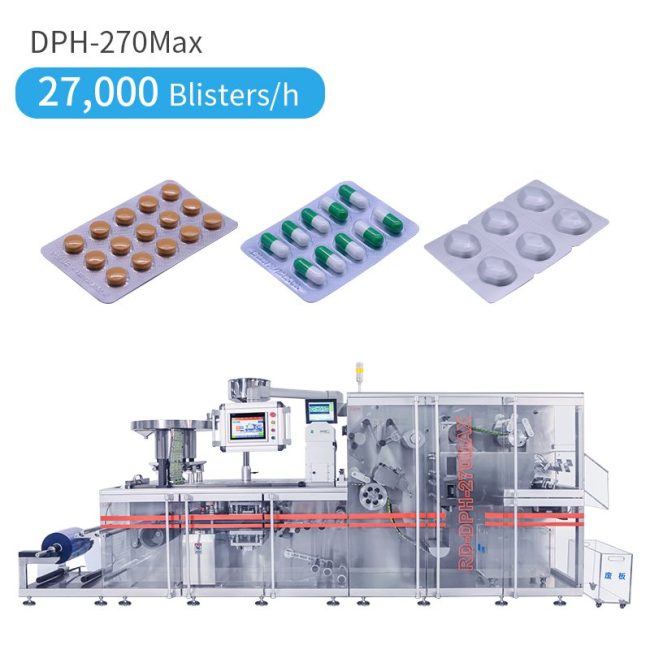
Προκλήσεις και περιορισμοί της συσκευασίας σε φουσκάλες
Περιβαλλοντικές Σκέψεις
Οι συσκευασίες σε μορφή κυψέλης αντιμετωπίζουν αρκετές περιβαλλοντικές προκλήσεις:
Πολυπλοκότητα Υλικού: Οι πολλαπλές στρώσεις μπορούν να περιπλέξουν την ανακύκλωση
Πλαστικό περιεχόμενοΠολλές συνθέσεις χρησιμοποιούν μη βιοδιασπώμενα υλικά
Αναλογία συσκευασίας προς προϊόνΣχετικά υψηλό βάρος συσκευασίας προς προϊόν
Δυσκολίες χωρισμούΟι καταναλωτές σπάνια διαχωρίζουν τα εξαρτήματα για ανακύκλωση
Απαιτήσεις Ενέργειας ΠαραγωγήςΟι διαδικασίες διαμόρφωσης και σφράγισης απαιτούν ενέργεια
Όγκος αποβλήτων: Πιο ογκώδες από ορισμένες εναλλακτικές μορφές συσκευασίας
Η βιομηχανία συνεχίζει να εργάζεται πάνω σε πιο βιώσιμες εναλλακτικές λύσεις που διατηρούν την προστασία, μειώνοντας παράλληλα τις περιβαλλοντικές επιπτώσεις.
Παράγοντες κόστους
Αρκετοί παράγοντες συμβάλλουν στο κόστος συσκευασίας σε μορφή blister:
Έξοδα ΥλικώνΟι ειδικές μεμβράνες φραγμού μπορεί να είναι δαπανηρές
Επένδυση σε εξοπλισμό: Η ενσωμάτωση με μηχανές πρέσας δισκίων απαιτεί κεφάλαιο
Κόστος Εργαλείων: Εργαλεία διαμόρφωσης κατά παραγγελία για συγκεκριμένα προϊόντα
Απαιτήσεις επικύρωσηςΗ φαρμακευτική επικύρωση προσθέτει κόστος
Περιορισμοί ταχύτητας γραμμήςΕνδέχεται να μην αντιστοιχεί στις ταχύτερες εξόδους της μηχανής πρέσας δισκίων
Χρόνος αλλαγής: Η εναλλαγή μεταξύ προϊόντων απαιτεί χρόνο διακοπής λειτουργίας
Αυτά τα κόστη πρέπει να εξισορροπούνται με τα οφέλη προστασίας και τα πλεονεκτήματα μάρκετινγκ κατά την επιλογή μορφών συσκευασίας.
Περιορισμοί Χρήσης
Ορισμένοι πρακτικοί περιορισμοί επηρεάζουν τις εφαρμογές συσκευασίας κυψέλης:
Δυσκολίες ανοίγματοςΜπορεί να προκαλέσει χρήστες με περιορισμένη επιδεξιότητα
Περιορισμοί μεγέθουςΠεριορισμένες διαστάσεις κοιλότητας για μεγαλύτερες δοσολογικές μορφές
Συμβατότητα προϊόντοςΔεν επιβιώνουν όλα τα προϊόντα από τη διαδικασία διαμόρφωσης/σφράγισης
Ευαισθησία στη θερμότηταΟι θερμοκρασίες σφράγισης ενδέχεται να επηρεάσουν ορισμένα φάρμακα
Ενσωμάτωση ΜηχανήςΑπαιτείται συντονισμός με τους ρυθμούς εξόδου της μηχανής πρέσας δισκίων
Ευελιξία ΣχεδιασμούΟρισμένα σχήματα και μεγέθη αποδεικνύονται δύσκολα στο να δημιουργηθούν φουσκάλες
Αυτοί οι περιορισμοί ενδέχεται να καταστήσουν προτιμότερη την εναλλακτική συσκευασία για ορισμένα φαρμακευτικά προϊόντα.
Η ενσωμάτωση της τεχνολογίας πρέσας δισκίων με τη συσκευασία σε κυψέλες
Επιπτώσεις στην ποιότητα των δισκίων στις λειτουργίες των κυψελών
Τα χαρακτηριστικά των δισκίων από τη μηχανή πρέσας δισκίων επηρεάζουν άμεσα τη συσκευασία σε κυψέλες:
Ευθρυπτότητα δισκίουΤα εύθρυπτα δισκία ενδέχεται να δημιουργήσουν σκόνη στις μηχανές παρασκευής κυψελών.
Διαστατική ΣυνέπειαΟι παραλλαγές επηρεάζουν τις απαιτήσεις σχεδιασμού τσέπης
Ορισμός ακμής: Οι αιχμηρές άκρες μπορεί να τρυπήσουν τα υλικά των κυψελών
Φινίρισμα επιφάνειαςΕπηρεάζει την κίνηση κατά την πλήρωση των κυψελών
Προφίλ σκληρότηταςΕπηρεάζει την αντοχή σε ζημιές κατά τη συσκευασία
Συνέπεια βάρουςΕπηρεάζει την εφαρμογή εντός τυποποιημένων μεγεθών κοιλοτήτων
Η βέλτιστη ενσωμάτωση απαιτεί ευθυγράμμιση μεταξύ των παραμέτρων της πρέσας δισκίων και των προδιαγραφών της μηχανής blister.
Συγχρονισμός Γραμμής Παραγωγής
Η αποτελεσματική κατασκευή απαιτεί συντονισμό μεταξύ των διαδικασιών πρέσας δισκίων και παραγωγής κυψελών:
Ταίριασμα ταχύτηταςΕυθυγράμμιση της εξόδου της πρέσας δισκίων με την χωρητικότητα της μηχανής blister
Συστήματα BufferΔιαχείριση ροής παραγωγής μεταξύ λειτουργιών
Ηλεκτρονική ΕνσωμάτωσηΕπικοινωνία μεταξύ συστημάτων ελέγχου εξοπλισμού
Βρόχοι ποιοτικής ανατροφοδότησης: Κοινή χρήση δεδομένων σε πραγματικό χρόνο για προσαρμογές διεργασιών
Συντονισμός ΜετάβασηςΣυγχρονισμένες μεταβάσεις προϊόντων
Προγραμματισμός Συντήρησης: Ευθυγραμμισμένος χρόνος διακοπής λειτουργίας για μεγιστοποίηση της παραγωγικότητας
Αυτός ο συγχρονισμός ελαχιστοποιεί το απόθεμα εργασιών σε εξέλιξη, διατηρώντας παράλληλα την ποιότητα σε όλη τη ροή παραγωγής.
Μελλοντικές τάσεις ολοκλήρωσης
Οι αναδυόμενες τεχνολογίες υπόσχονται στενότερη ενσωμάτωση:
Συνεχής Παραγωγή: Άμεση πίεση δισκίου στη σύνδεση κυψέλης χωρίς ενδιάμεση αποθήκευση
Δοκιμή έκδοσης σε πραγματικό χρόνοΕπαλήθευση ποιότητας χωρίς καθυστερήσεις στην παραγωγή
Ευφυή ΣυστήματαΑυτορυθμιζόμενες παράμετροι με βάση τα χαρακτηριστικά του προϊόντος
Τεχνολογία Ψηφιακών ΔιδύμωνΕικονική μοντελοποίηση πλήρων διαδικασιών παραγωγής
Ευέλικτη ΠαραγωγήΤαχεία εναλλαγή μεταξύ προϊόντων
Ενσωμάτωση σειριοποίησηςΠαρακολούθηση από άκρο σε άκρο από την πρέσα δισκίων έως την τελική συσκευασία
Αυτές οι εξελίξεις θα βελτιστοποιήσουν περαιτέρω τη σύνδεση μεταξύ της παραγωγής δισκίων και των λειτουργιών συσκευασίας σε κυψέλες.
Σκέψεις σχεδιασμού συσκευασίας κυψέλης
Σχεδιασμός κυψέλης που ταιριάζει με τα χαρακτηριστικά του προϊόντος
Η αποτελεσματική συσκευασία blister απαιτεί ευθυγράμμιση του σχεδιασμού με τα χαρακτηριστικά του προϊόντος:
Μέγεθος και σχήμαΟι διαστάσεις της κοιλότητας πρέπει να είναι κατάλληλες για δισκία από μηχανές πρέσας δισκίων
Ευαισθησία προϊόντοςΑπαιτήσεις φραγμού με βάση το προφίλ σταθερότητας
Διαχείριση αναγκών: Εξέταση των απαιτήσεων της διαδικασίας πλήρωσης
Απαιτήσεις μάρκετινγκ: Οπτική παρουσίαση του προϊόντος
Δημογραφικά στοιχεία χρηστώνΙκανότητες και προτιμήσεις του πληθυσμού-στόχου
Περιβάλλον ΔιανομήςΠροστασία από αναμενόμενες συνθήκες
Κανονιστικές απαιτήσειςΣυμμόρφωση με τους ισχύοντες κανονισμούς συσκευασίας
Ο προσεγμένος σχεδιασμός βελτιστοποιεί τόσο την αποδοτικότητα της παραγωγής όσο και την ικανοποίηση του τελικού χρήστη.
Σχεδιασμοί ανθεκτικοί στα παιδιά και φιλικοί προς τους ηλικιωμένους
Οι σύγχρονες κυψέλες πρέπει να εξισορροπούν την ασφάλεια και την προσβασιμότητα:
Αντίσταση ώθησηςΕπαρκής αντοχή υποστήριξης για αντοχή σε παιδιά
Σχέδια με ώθηση αποκόλλησηςΑπαιτούνται συντονισμένες ενέργειες για το άνοιγμα
Γνωστικές ΠροκλήσειςΣχεδιάστε ενδείξεις που οι ενήλικες καταλαβαίνουν αλλά τα παιδιά όχι
Ισορροπία Φυσικής ΔύναμηςΑνθεκτικό στα παιδιά αλλά διαχειρίσιμο και για ηλικιωμένους
Σαφείς οδηγίες: Σαφείς οδηγίες ανοίγματος στη συσκευασία
Πρωτόκολλα ΔοκιμώνΠληροί τα κανονιστικά πρότυπα και για τα δύο κοινά
Αρχές Καθολικού Σχεδιασμού: Προσβάσιμο για όλες τις σωματικές ικανότητες
Αυτές οι σκέψεις είναι ιδιαίτερα σημαντικές για φάρμακα που παρουσιάζουν κινδύνους σε περίπτωση τυχαίας κατάποσης.
Ενσωμάτωση Τεχνολογίας
Οι σύγχρονες συσκευασίες blister ενσωματώνουν ολοένα και περισσότερο προηγμένες τεχνολογίες:
Ετικέτες NFCΕπιτρέψτε την ψηφιακή αλληλεπίδραση με τη συσκευασία
Κωδικοί QR: Σύνδεσμος προς πληροφορίες προϊόντος και έλεγχο ταυτότητας
Ηλεκτρονικές προθήκες χαρτιούΔυναμική παρουσίαση πληροφοριών
Δείκτες θερμοκρασίας: Εμφάνιση εάν το προϊόν έχει υπερβεί τα όρια αποθήκευσης
Παρακολούθηση Συμμόρφωσης: Παρακολούθηση μοτίβων ανοίγματος δεμάτων
Χαρακτηριστικά κατά της παραποίησηςΟλογραφικά στοιχεία ή στοιχεία που αλλάζουν χρώμα
Έξυπνοι αισθητήρες συσκευασίαςΠαρακολούθηση της κατάστασης του προϊόντος
Αυτές οι τεχνολογίες επεκτείνουν τη λειτουργικότητα των κυψελών πέρα από τον βασικό περιορισμό και την προστασία.
Εφαρμογές πέρα από τα φαρμακευτικά προϊόντα
Καταναλωτικά προϊόντα σε συσκευασία κυψέλης
Η μορφή blister έχει επεκταθεί σε πολλές κατηγορίες καταναλωτών:
Ηλεκτρονικά αξεσουάρΚάρτες μνήμης, μπαταρίες, μικρά εξαρτήματα
Προϊόντα προσωπικής φροντίδαςΞυράφια, εφαρμοστές καλλυντικών, οδοντιατρικά εργαλεία
Προμήθειες γραφείουΣτυλό, γόμες, μικρά είδη οργάνωσης
Στοιχεία υλικού: Συνδετήρες, μικρά εξαρτήματα, ανταλλακτικά
Παιχνίδια και Συλλεκτικά ΕίδηΦιγούρες δράσης, συλλεκτικά αντικείμενα, κομμάτια παιχνιδιού
Προϊόντα Τροφίμων: Τσίχλες, καραμέλες, είδη με ελεγχόμενη μερίδα
Ιατρικές συσκευέςΦακοί επαφής, είδη δοκιμών, είδη πρώτων βοηθειών
Αυτές οι εφαρμογές αξιοποιούν την ορατότητα, την προστασία και την απόδειξη παραβίασης της τεχνολογίας κυψέλης φαρμακευτικής ποιότητας.
Εφαρμογές ιατρικών συσκευών
Οι εξειδικευμένες ιατρικές εφαρμογές περιλαμβάνουν:
Αποστειρωμένα χειρουργικά εργαλείαΕργαλεία μιας χρήσης σε κυψέλες που ανοίγουν με αποκόλληση
Εμφυτεύσιμες συσκευέςΜέγιστη προστασία για κρίσιμες εφαρμογές
Κιτ διαγνωστικών εξετάσεωνΠροστατευμένα αντιδραστήρια και υλικά δοκιμών
Προϊόντα περιποίησης τραυμάτωνΑποστειρωμένοι επίδεσμοι και υλικά θεραπείας
Συνδυασμοί φαρμάκων-συσκευών: Φαρμακευτική αγωγή με σχετικά συστήματα χορήγησης
Υλικά συλλογής δειγμάτωνΑποστειρωμένες συσκευές συλλογής για εξετάσεις
Είδη οικιακής υγειονομικής περίθαλψηςΙατρικός εξοπλισμός για χρήση από ασθενείς
Αυτές οι εφαρμογές απαιτούν τα υψηλότερα επίπεδα προστασίας και διασφάλισης στειρότητας.
Επιλογή της σωστής λύσης συσκευασίας κυψέλης
Παράγοντες αξιολόγησης για φαρμακευτικές εφαρμογές
Όταν επιλέγετε συσκευασίες blister για προϊόντα από μηχανές πρέσας δισκίων, λάβετε υπόψη:
Προφίλ Σταθερότητας Προϊόντος: Υγρασία, οξυγόνο, ευαισθησία στο φως
Απαιτούμενη διάρκεια ζωής: Απαιτούμενη διάρκεια προστασίας
Περιβάλλον Διανομής: Θερμοκρασία, υγρασία, διακυμάνσεις πίεσης
Κανονισμοί Αγοράς-Στόχου: Περιφερειακές απαιτήσεις συσκευασίας
Δημογραφικά στοιχεία χρηστώνΧαρακτηριστικά πληθυσμού ασθενών
Όγκος Παραγωγής: Μεγέθη παρτίδων και συχνότητα παραγωγής
Απαιτήσεις μάρκετινγκ: Προβολή και παρουσίαση της επωνυμίας
Στόχοι Βιωσιμότητας: Παράγοντες περιβαλλοντικών επιπτώσεων
Η συστηματική αξιολόγηση αυτών των παραγόντων οδηγεί στη βέλτιστη επιλογή συσκευασίας blister.
Ενσωμάτωση με Συστήματα Παραγωγής
Λάβετε υπόψη αυτούς τους παράγοντες κατά τη σύνδεση με λειτουργίες πρέσας δισκίων:
Συμβατότητα ρυθμού παραγωγής: Αντιστοίχιση ταχυτήτων μεταξύ συστημάτων
Ευελιξία μορφής: Δυνατότητα προσαρμογής σε διάφορα μεγέθη προϊόντων
Αποδοτικότητα μετάβασης: Χρόνος που απαιτείται για την αλλαγή προϊόντων
Ενσωμάτωση Συστήματος ΕλέγχουΕπικοινωνία μεταξύ εξοπλισμού
Δυνατότητες Παρακολούθησης Ποιότητας: Ευθυγράμμιση συστημάτων επιθεώρησης
Απαιτήσεις χώρου: Ζητήματα φυσικής διάταξης
Απαιτήσεις Δεξιοτήτων Χειριστή: Ανάγκες εκπαίδευσης για το προσωπικό
Η σωστή ενσωμάτωση διασφαλίζει την ομαλή ροή παραγωγής από τη μηχανή πρέσας δισκίων έως τη συσκευασία.
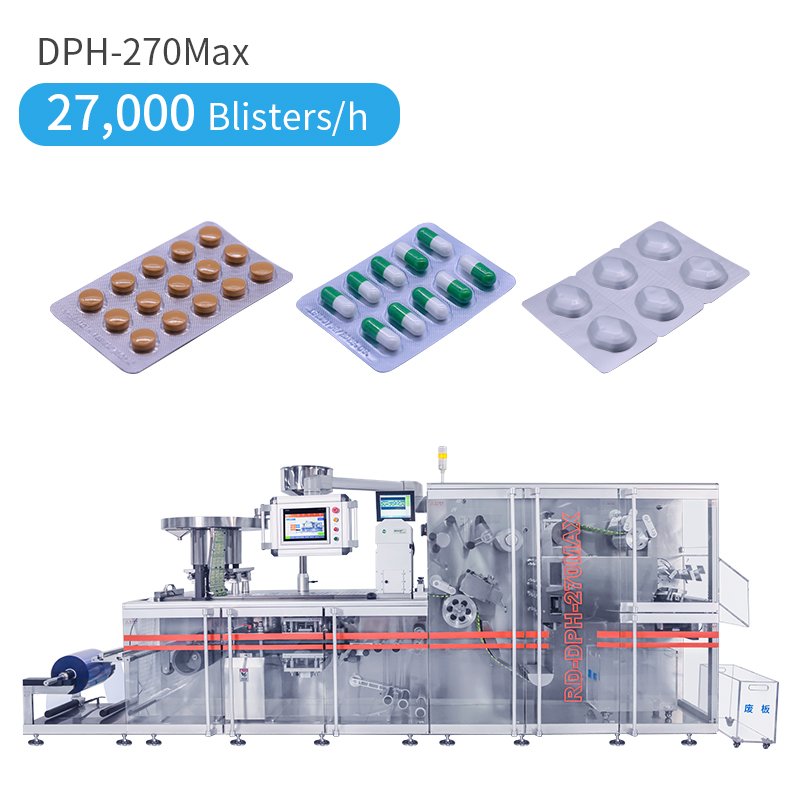
Σύναψη
Η συσκευασία σε κυψέλες αντιπροσωπεύει μια ουσιαστική τεχνολογία στη φαρμακευτική βιομηχανία, παρέχοντας κρίσιμη προστασία για προϊόντα που κατασκευάζονται σε μηχανές πρέσας δισκίων και περιστροφικές μηχανές πρέσας δισκίωνΑπό την βασική αντοχή στην υγρασία έως τα προηγμένα χαρακτηριστικά έξυπνης συσκευασίας, οι συσκευασίες blister συνεχίζουν να εξελίσσονται για να καλύπτουν τις μεταβαλλόμενες ανάγκες του κλάδου, διατηρώντας παράλληλα τα βασικά τους οφέλη, όπως η προστασία του προϊόντος, η προστασία από παραβίαση και η ευκολία του χρήστη.
Για εξειδικευμένη καθοδήγηση σχετικά με την επιλογή της βέλτιστης λύσης συσκευασίας blister για τα φαρμακευτικά σας προϊόντα, επικοινωνήστε με τους ειδικούς συσκευασίας μας σήμερα. Τα προϊόντα σας αξίζουν προστασία αντίστοιχη με την ποιότητά τους.
